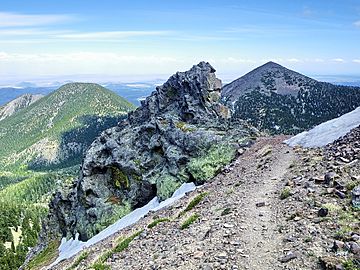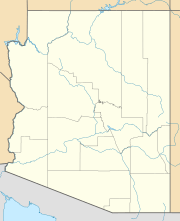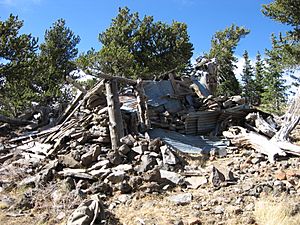Doyle Peak facts for kids
Quick facts for kids Doyle Peak |
|
|---|---|

Doyle Peak (left, flat top) and Fremont Peak from the east side of Agassiz Peak.
|
|
| Highest point | |
| Elevation | 11,464 ft (3,494 m) NAVD 88 |
| Prominence | 660 ft (201 m) |
| Geography | |
| Location | Coconino County, Arizona, U.S. |
| Parent range | San Francisco Peaks |
| Topo map | USGS Humphreys Peak |
| Climbing | |
| Easiest route | Hike |
Doyle Peak is a tall mountain located in the San Francisco Peaks of northern Arizona, United States. It stands at about 11,464 feet (3,494 meters) high. This makes it the fourth highest peak in Arizona. Interestingly, on old maps, this mountain was called "Schultz Peak." The name "Doyle Peak" used to refer to a different ridge nearby.
Contents
Exploring Doyle Peak
Hiking up Doyle Peak can be an exciting adventure! The path you choose affects how challenging it is. You need to be careful to avoid areas with loose rocks, called scree slopes. These slopes are very steep and can slide easily.
The easiest way to reach the top is by hiking the Weatherford Trail to Schultz Saddle. From there, you follow an old mule trail to the summit. Another way is to follow the ridge from Lockett Meadow. From a distance, Doyle Peak looks like a rounded mountain. But up close, you'll see it's actually a ridge that stretches from southwest to northeast. The very top of the peak is quite flat and wide in several spots.
The Historic Cabin and Telescope
On the south side of Doyle Peak's summit, there's a small building. Some people call it a shepherd's cabin. But it was actually built in 1927 by the Lowell Observatory. They built it to hold a special telescope.
A High-Altitude Observatory
The observatory director, Dr. V. M. Slipher, chose this spot. He found two Bristlecone Pine trees that lined up perfectly. These trees were cut down and used to support the telescope's main axis. The telescope and its parts were built by Stanley Sykes from Lowell Observatory. A local stonemason named Ramon Vilma built the cabin itself.
The cabin had a metal roof that could roll off. This allowed the telescope to see the sky. The telescope parts were brought up the mountain by truck and then by mule. There were two telescopes: one was 12 inches (30 cm) wide, and the other was 15 inches (38 cm) wide.
The World's Highest Telescope
From 1927 to 1932, this was the highest place on Earth where people observed the sky with a telescope! Its main goal was to study planets, stars, and nebulae. Being so high up meant the air was clearer. This was especially good for seeing ultraviolet and infrared light.
A similar telescope was built at Lowell Observatory's main campus. This allowed scientists to compare observations from both sites. The telescope at the main campus is still used today.
Meteor Research and New Technology
Between 1931 and 1933, scientists from Harvard and Cornell universities used the Schultz Peak station. They were on a meteor expedition. They used special techniques to measure how fast meteors moved. They also recorded meteors from two different places to figure out their height.
In 1933, a new way to coat telescope mirrors was tested here. This new method, called vacuum aluminization, made mirrors much better. For a short time, the telescope on Schultz Peak was the largest in the world to have this new coating! This method is still used today for most telescope mirrors. Many important discoveries were made using data from this station.
The Cabin Today
The telescope and its parts were removed from the cabin in 1937. The building was then left empty. By the 1970s, the roof had fallen in because of neglect and heavy winter snow. Hikers later rebuilt it into the cabin you see today. Keeping the cabin in good shape is an ongoing effort by hikers.
Many hikers and campers leave supplies inside the cabin. They also use items left by others when needed. If you visit, look for a waterproof container. It usually holds a log book and other information. Also, try to find the two Bristlecone tree stumps. These stumps were used to set up the original telescope. They are near the north and south walls of the cabin. Please enjoy and help protect this special place!
Recent Repairs
In August 2016, the cabin on Doyle Peak was rebuilt again. It wasn't made exactly like the original. But it was made functional for hikers. A new roof was added, along with a new east wall. A small fireplace was built with rocks, and some firewood was stacked inside. All the materials used were repurposed from what was already there. This included roof tin, old lumber, and rocks. New nails and tape were carried up the mountain. The main beams were cut from dead trees found on the mountain. No living trees were harmed for the building or for firewood.



